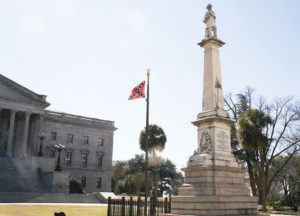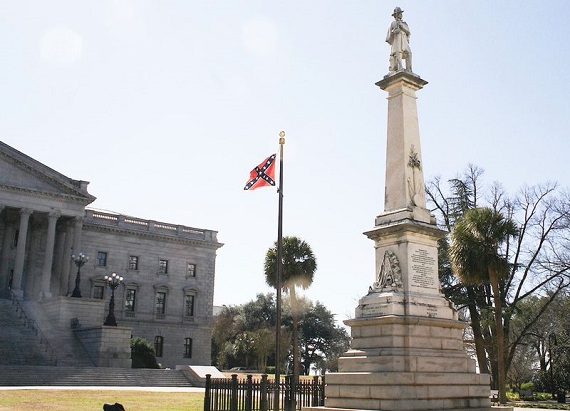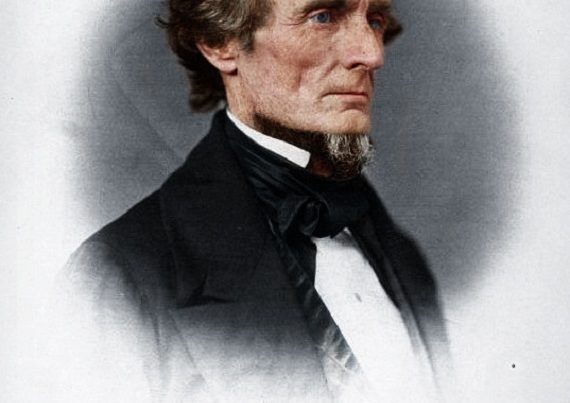
As in the practice of lingchi, the ancient Chinese form of slow and painful execution by a thousand cuts, Southern history and tradition are today dying a similar death. The first of these virtual cuts was inflicted over twenty years ago in South Carolina when the Confederate Battle Flag was taken down from the dome of the State Capitol in Columbia. The Confederacy’s wartime banner had been added to the U. S. and State Flags in April of 1961 to mark the hundredth anniversary of the War Between the States and it remained flying atop the dome for four decades without any undue protest. In in year 2000, however, the NAACP began a movement to have the Battle Flag removed and that year, after much discussion with the State Legislature, a compromise was finally reached to relocate the flag to a Confederate memorial on the Capital grounds.
A year later, the second attempt to inflict a historical cut was made when another flag controversy erupted in Mississippi over the use of the Confederate Battle Flag as part of that State’s flag . . . a banner that had flown without any serious objection since 1894. A new flag was proposed that would replace the Confederate emblem in the canton with one showing twenty stars on a blue field. A state-wide referendum was then held to either retain the current flag or adopt the proposed new design. The result was an overwhelming vote of more than sixty-four per cent in favor of keeping the Confederate-themed flag. Considering that over forty-three per cent of Mississippi’s population at that time was non-white, if as many minority residents were opposed to the flag as claimed, the vote should have been far more close . . . if not one for change
However, the actual Confederate cut in Mississippi was finally made in June of last year when Republican Governor Tate Reeves signed a bill “retiring” the State Flag and ordered the State’s Department of Archives and History to create a commission for the design of a new flag. In a state-wide referendum that this time allowed no choice between the Confederate-themed flag and the one being proposed, only a yes-or-no vote on the latter, the new design composed of a white magnolia surrounded by twenty-one stars and the phrase “In God We Trust” was adopted and became the new State Flag this January.
The year 2001 also saw another flag battle shaping up in Georgia where the State’s Democratic governor, Roy Barnes, and the State Legislature decided to change the State Flag that had been adopted in 1956. Two-thirds of the Georgia flag at that time displayed the Confederate Battle Flag and objections to retaining it had been slowly rising among some in the State. Without any public vote, the flag was officially changed to a design showing the State Seal on a field of dark blue with a strip containing a series of historic Georgia flags, including the existing one with the Battle Flag , strung out below the seal.
Criticism of the design, which many dubbed as “Barnes’ rag,” was immediately raised. Later that year, in a survey on state flags by the North America Vexillogical Association, the new Georgia flag was voted the nation’s worst by far and the Association itself called it one that “violates all the principles of good flag design.” Some critics even went so far as to say that the design looked more like a souvenir place mat than a proper state flag.
In November of the following year, the Georgia flag controversy and its arbitrary change were instrumental in bringing about Governor Barnes’ reelection defeat. Upon taking office in 2003, the new Republican Governor, Sonny Perdue, as he had promised during his campaign, ordered a new flag to be designed by the State Legislature and a state-wide poll then taken to either retain the 2001 flag design or adopt the proposed new one. As was the case in Mississippi, however, the Battle-Flag-themed State Flag was not to be included on the ballot. By a huge vote of more than seventy-three per cent, the new design was approved . . . one which closely resembled the first Confederate National Flag, the “Stars and Bars.”
In the summer of 2015, the anti-Confederate cuts became far more deadly when, in South Carolina, a crazed North Carolina resident entered the Emanuel African Methodist Church in Charleston and shot to death nine black congregants. This single insane act instituted a new cry from social justice warriors that finally succeeded in removing the Battle Flag in Columbia entirely. The rationale for the flag frenzy being that the gunman had made a video in which his racist rantings were recorded with a Confederate Battle Flag draped behind him.
After the Confederate flag was forever furled in Columbia, others throughout the South also began to come down, such as the ones that had flown over Fort Sumter in Charleston for generations, as well as those that lined the entrance to the former Museum of the Confederacy in Richmond and the “Stars and Bars” flag used at the Six Flags Over Texas theme park between Dallas and Fort Worth. The latest cry to take down Confederate flags soon became a widespread movement to also remove all Confederate monuments and memorials, as well as to erase all memory of anything or anyone connected with the Confederacy and the antebellum South.
Then, in 2017, the growing cry of protest developed into a deafening roar when a legitimate local rally to protest the removal of two Confederate statues in Charlottesville, Virginia, was invaded by outside mobs from both the extreme left and right. These unwanted and unlawful intruders turned the otherwise peaceful demonstration into a deadly riot that became not only a nationwide anti-Confederate cause célèbre but the reason for a political attack on former President Trump as well.
Because of the events in Charlottesville, many retail outlets throughout America ceased to offer either Confederate flags or any type of Confederate-themed merchandise. To take it a step further, this year Congress and the Department of Defense created a national committee to remove from various federal facilities “all names, symbols, displays, monuments and paraphernalia connected in any way with the Confederacy.” This type of hysterical reaction can even be seen now in public education and information, as well as in the media . . . such as the constant use of a video clip showing one individual waving a Confederate Battle Flag during this January’s unfortunate riot and intrusion into the U. S. Capitol.
Another example of the controversy’s effect on public information can be found if one looks up the subject of Confederate Flags on the internet. In addition to showing illustrations and explanations of the three National Flags of the Confederacy and the Battle Flag, the items also list five individuals who are considered most related to such flags, as well as five flags they feel are connected to those of the Confederacy. Two of the individuals shown are Generals P. G. T. Beauregard and Joseph Johnston, but no explanation is given as to why these two are cited. While the biography of General Johnston is quite straightforward, in the one on General Beauregard they cannot resist describing him as “ a treasonous general officer who started the American Civil War.” The other three people are civilians who actually had a more direct connection with Confederate flags, Nicola Marschall, William Porcher Miles and William Tappan Thompson.
The reference to Marschall is certainly a most proper one, as the Prussian-born artist from Alabama had designed both the first National Flag of the Confederacy, the “Stars and Bars,” and the Confederacy’s official gray military uniform. The same holds true for William Miles, the Confederate congressman from South Carolina and former mayor of Charleston who designed the Confederate Battle Flag. William Thompson’s inclusion, however, is merely more of a politically-motivated effort to demean the Confederacy and paint it as nothing more than a racist entity.
Thompson was a white supremacist from Ohio who relocated to Georgia in the 1850s where he co-founded Savannah’s “Daily Morning News” and served as that newspaper’s editor. In 1863, after the the second National Flag of the Confederacy, the “Stainless Banner,” was adopted, Thompson praised it in a series of editorials. His reasoning, however, did not reflect the meaning intended by the legislator who introduced the bill for the flag’s adoption, Confederate Congressman Alexander Boteler of Virginia, who said the white in the flag signified purity and truth. Thompson imagined rather that the flag represented the white race and even called it the “White Man’s Flag.” The former Northerner editorialized that “as a people, we are fighting to maintain the heaven ordained supremacy of the white man over the inferior colored races: a white flag would thus be emblematical of our cause.”
Then we come to the five flags which the people who run the internet feel somehow have a relationshop to those of the Confederate States of America. Of the five, the only flag that has any reasonable connection would be the initial flag of South Carolina’s secession, and the inspiration for one of the South’s greatest marching songs, the single-starred “Bonnie Blue Flag.” The inclusion of the present South Carolina State Flag and those of Alabama and Florida, with the latter two’s Cross of Saint Andrew motif, seems to smack more of an effort to evoke a charge of guilt by association rather than any real comparison. The last flag presented as being analogous with those of the Confederacy is, however, perhaps the unkindest and most outrageously egregious cut of all . . . the swastika banner of Nazi Germany.






